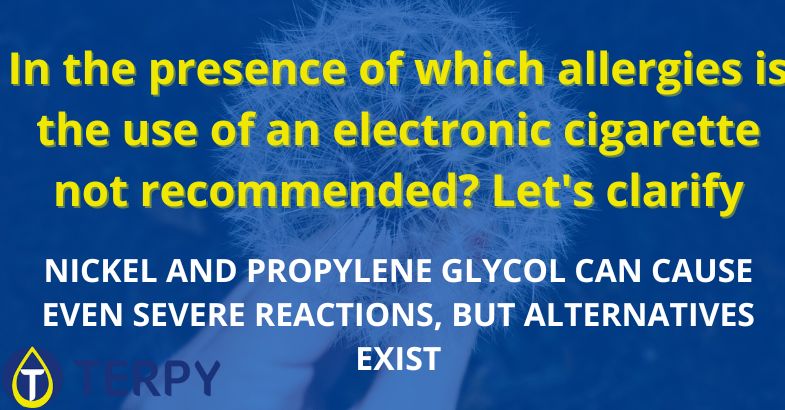Published on: 30/11/2023
NICKEL AND PROPYLENE GLYCOL CAN CAUSE EVEN SEVERE REACTIONS, BUT ALTERNATIVES EXIST
The electronic cigarette is a device that can help smokers to abandon the habit of smoking and reduce nicotine addiction; however, it can cause problems for allergy sufferers, due to elements such as nickel or chemical components of e-cigarette liquids such as Propylene Glycol.
Let’s first find out how allergies work, what the main allergic reactions caused by e-cigs are and what the possible solutions may be.
Read also: Electronic pipe: how this nice alternative to traditional pipes works
What are allergies and how do they manifest themselves
Allergy can be defined as an excessive reaction of our immune system to an external substance, the allergen, which our body considers dangerous. The body’s abnormal response manifests itself through the release of some “chemical mediators“, on all histamine, in the body. Symptoms may involve the respiratory system (sneezing, wheezing), the nose (dripping, rhinitis), the eyes (tearing, redness and conjunctivitis), and the skin (redness and various dermatological reactions).
The causes of allergies can be multiple: allergens present in the air such as animal hair or pollen, foods such as eggs, fish, shellfish or dried fruit, insect bites (wasps, bees and spiders), drugs or elements such as nickel.
Allergies are dealt with by the allergist, who after some tests (prick tests, patch tests, blood tests, etc.), makes the diagnosis and prescribes treatments, which are essentially preventive in nature: antihistamines, decongestants and corticosteroids are used to reduce symptoms, which can often be very annoying and, in some cases, even serious.


Electronic cigarette and allergies: what are the risks and side effects
The electronic cigarette can cause allergic reactions, mainly due to two substances: Propylene Glycol and nickel.
Propylene Glycol (PG) is a solvent used to dissolve flavorings in electronic cigarette liquid: together with Vegetable Glycerin (VG), it is the main component of e-cig bases.
In some cases, PG can cause a form of intolerance or even an allergy, which manifests itself with various symptoms: dry mouth, shortness of breath, increased nasal secretions, burning and sore throat, skin rashes, even painful, around the mouth or oral mucosa.
Nickel is responsible for very widespread forms of intolerance or allergy. In the electronic cigarette, nickel is found both in the vapor and in the metal components of the e-cig: drip tip, top cap, deck, resistors. This metal, very widespread in nature, can cause skin irritations, such as contact dermatitis, and other symptoms such as tiredness, widespread malaise, swelling, gastrointestinal disorders, headache, urinary disorders and neurological disorders such as dizziness.
So can allergy sufferers smoke electronic cigarettes? Anyone who is allergic to the two substances just described should avoid coming into contact with them. However, there are some solutions.
Read also: Dry hit and electronic cigarette: why it happens and how to avoid the famous ‘blockades’
How to prevent allergies caused by electronic cigarettes
To prevent allergies related to the use of e-cigarettes we have several options.
In case of allergy to Propylene Glycol, we can opt for bases without this substance: there are full VG bases on the market (with only Vegetable Glycerin) or liquids without PG. If we make the bases, we can dilute the glycerol with demineralized water and use resistances no higher than 0.8 ohm.
If the allergy is caused by nickel instead, you need to pay attention to all the metal parts of the e-cig and replace them with hypoallergenic alternatives: drip tip, top cap, bells, deck and resistors.


Metal drip tips can be replaced by glass, wooden or resin mouthpieces. Top caps, bells and decks are usually made of metal, but if of good quality, stainless steel, the quantity of nickel is reduced and the passage to the outside is almost absent (but not entirely, so it is good to pay attention).
The resistors are almost all made of nickel alloys: NiFE (Nickel + Iron) and Ni80 (Nickel + Chromium) are not recommended for allergic vapers due to the high metal content in the composition. However, there are nickel-free alternatives on the market, which are preferable even if you are simply intolerant to the metal.
For nickel intolerant vapers who prefer regenerable resistors, resistive wires are available that are completely nickel-free, such as wires made of iron, chromium and aluminium.
Nickel-free electronic cigarettes are therefore suitable for vapers allergic to nickel, while those who are allergic to PG can choose bases without this substance. However, what is strongly recommended is to contact your doctor for all possible clarifications.
In conclusion
Although the e-cig is much safer and decidedly less harmful than the traditional cigarette, it could cause annoying, even serious, problems in allergy sufferers.
In particular, allergy to Propylene Glycol (PG) can cause shortness of breath, sore throat, swelling and blisters around the mouth, while allergy to nickel, caused by the metal components of the e-cig, causes various disorders such as tiredness, malaise , gastrointestinal problems, headaches and dizziness.
In any case, alternatives exist: full-VG (Vegetable Glycerin) bases, glass and wooden mouthpieces, nickel-free resistors can avoid problems linked to allergic reactions due to this metal. A medical consultation can help avoid any risk.










